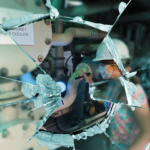A small modular reactor’s demise calls for big change in Energy Department policy
By Henry Sokolski | November 14, 2023
 Power plant control room simulator, for a small modular reactor. Image courtesy of NuScale Power/NuScale Test Facility Tours.
Power plant control room simulator, for a small modular reactor. Image courtesy of NuScale Power/NuScale Test Facility Tours.
NuScale Power Corp., which is developing America’s flagship small modular reactor (SMR), has lost its only firm utility customer, the Utah Associated Municipal Power System. That utility pulled the plug last week on the project just days after Iceberg Research, a financial advisory firm, urged investors to short sell NuScale (that is, to bet the value of its shares will decrease). Shares, worth $14.87 in August, plummeted more than 85 percent, closing Monday at $2.23.
Regrettably, the US Energy Department has already given NuScale hundreds of millions in grants, and the US Export Import Bank and the US Development Finance Corporation have promised NuScale another $4 billion in financing toward a plant in Romania. NuScale’s latest loss could cast a financial pall over its parent company, the Fluor Corporation, and other Energy Department-backed SMR projects, X-Energy and Oklo.
How could this happen? Simple: The Energy Department overrode market signals, went all in with SMRs and NuScale, and stuck US taxpayers with the tab. Sadly, this is nothing new. Think Solyndra, ethanol mandates, Fisker automobiles, fast breeder reactors, and synthetic fuels.
The NuScale case, however, is worse. In the Energy Department’s zeal to sell SMRs so the country can get to net zero carbon dioxide emissions, the department failed to focus on its primary missions. These include setting energy cleanliness and efficiency standards, assuring nuclear security, spotlighting energy market trends, and conducting basic energy research to validate unproven energy concepts—e.g., fusion power—rather than commercializing systems we know already work — e.g., fission reactors. That failure of focus raises obvious questions.
Did the Energy Department do due diligence in assessing NuScale’s financial health and integrity? Did it properly weigh independent analyses that questioned the economic and environmental viability of small modular reactors more generally?Also, what of the nuclear security issues that building these plants in war zones raise?
The State and Energy departments have been pushing federal financing to export SMRs to Ukraine, its immediate neighbors, and East Asia. All of the proposed projects are within shooting distance of Russian, Chinese, and North Korean missiles. Worse, officials in Moscow, Beijing, and Pyongyang have all threatened to attack such plants.
Japan’s prime minister and Ukrainian officials have called for increased hardening and military protections for their reactors (including installing missile defenses as Belarus has at its reactor). The Energy Department, however, has yet to offer any narrative on how it might keep US-exported reactors safe against such assaults.
Then there are the nuclear weapons proliferation headaches that the exporting of small fast reactors present. One of the Energy Department’s favorite SMR projects, Bill Gates’ Natrium fast reactor, is largely a knock off of the Prism fast breeder reactor. It was designed to produce plutonium, much of which would be super weapons-grade plutonium (i.e., even easier to make into weapons than what our military uses). TerraPower, which is developing Natrium, says it plans on exporting Natrium plants. One would think the Energy Department could have explained how such reactor technology can be shared without spreading fissionable material to make nuclear bombs. So far, it has not.
Some argue that providing nuclear alternatives to Russian natural gas and preventing global warming should overshadow such proliferation concerns. Yet, most of Russia’s top gas customers are now buying elsewhere. As for fighting global warming, victory is only possible by reducing carbon dioxide emissions in the cheapest, quickest fashion. SMRs are neither quick nor cheap.
Both the nuclear industry and its critics have long favored using marginal abatement cost models to determine which energy fixes to make first to curb carbon emissions at the lowest cost. Using these models, it’s clear that making natural gas substitutions for coal-fired plants, increasing efficiencies, reducing energy demand, improving electrical transmission and storage systems, and tapping renewables all should come well before building new nuclear plants. Unfortunately, the Energy Department has yet to reference any of these models in its public statements about SMRs.
So how is the misplaced confidence in SMRs best remedied?
First, Congress should wind down the funding of Energy Department schemes to commercialize energy “winners,” nuclear or nonnuclear. Instead, the department and Congress should focus on setting energy and cleanliness goals and deadlines. To incentivize industry to meet them, the Energy Department should consider offering industry prizes.
Second, the Energy Department should make the most favored greenhouse gas cost abatement models, such as the popular McKinsey Company package, publicly available for all to use and improve. To feed better data into these models, Congress should require the Energy Department to report annually on the real costs (including subsidies) of different types of electrical generation, distribution, transmission, and storage systems.
Finally, before the United States exports any small modular reactors, the Energy Department and the Pentagon should clarify what can (and can’t) be done to protect them against military assaults and what the nuclear proliferation dangers are in the various nations that would operate them. It’s bad enough that Energy Department-backed reactors are burning holes in taxpayers’ pockets. At the very least, the Energy Department and the Pentagon should make sure that they don’t blow up in everyone’s face.
Together, we make the world safer.
The Bulletin elevates expert voices above the noise. But as an independent nonprofit organization, our operations depend on the support of readers like you. Help us continue to deliver quality journalism that holds leaders accountable. Your support of our work at any level is important. In return, we promise our coverage will be understandable, influential, vigilant, solution-oriented, and fair-minded. Together we can make a difference.
Keywords: Energy Department, NuScale, SMR, Terrapower, advanced reactors, nuclear energy, nuclear power, small modular reactors
Topics: Nuclear Energy
















It is a fairly odd stance that it would make more sense to pour money into fusion than SMRs on the premise that public money shouldn’t be spent “commercializing systems we know already work”. Well, if they do work then why is the author writing this article? He is contradicting himself. Observation of reality dictates that there is still work to be done before SMRs are a viable commercial reality.
What is the author’s real agenda here?
Govt subsidies often hide the true cost, which then later gets passed on rate payers. There’s also the possibility that the govt backs the wrong tech. HTR-PM designs seem far more promising than breeder reactor models, however small. Perhaps the US should work more closely with other countries who are looking at the same problems.